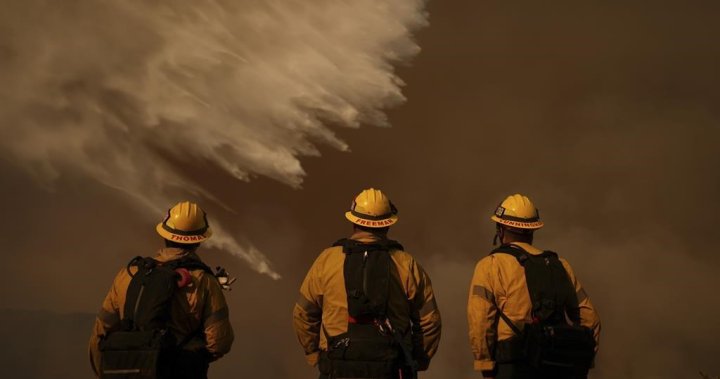Stronger winds are forecast for the Los Angeles area, triggering a red flag warning for much of the region.
These warnings are issued by the National Weather Service when hazardous conditions are present and could lead to the growth of wildfires.
At least 24 people were killed in the fires and thousands of homes and structures were destroyed.
Other teams from across Canada are heading out to help fight the wildfires, including two from Alberta.
Wayne Coulson, CEO of Vancouver Island-based Coulson Aviation, said four of his planes were involved in the fight.
The company has four planes working in the Los Angeles basin, including three Chinooks capable of carrying 3,000 gallons of water and an intelligence helicopter, Coulson told Global News.
He said that through the Quick Reaction Force program, initially created in 2019 by Orange County, they have fought more than 250 fires — more than half of them at night.
“Our main focus has been cleaning up both the Eaton fire, which we worked on, as well as the Palisades fire, cleaning them up as well,” Coulson said.

Receive national news daily
Get the day’s top news, politics, business and current affairs headlines delivered to your inbox once a day.
“So there they are, in hand. I would say the ground crews are doing a great job containing this fire as we prepare for, you know, a busy next few days here because we’re still on red flag alert here in the Los Angeles Basin. »

Coulson said the biggest challenge for his crews and others was the wind.
“Obviously there are two things that stand out from the fires here in Los Angeles, one is the wind,” he said.
“The fire caused by winds of over 80 miles per hour. You know, no one was going to be able to stop this. And everyone had to move aside. And if they didn’t have heavy air attacks to support the ground, these fires would have been much worse. »
Coulson said his planes dropped hundreds of thousands of gallons of water on the fires, mostly at night.
“I think the big message that we saw here is that flying at night made a significant difference because I’m sure it would have been double in size if they didn’t have the air support between the helicopters, between, you know, not only ourselves, but all the planes of the agency were flying at night,” he added.
Coulson said they are most effective at night when temperatures drop during the evening and relative humidity increases.
“And having 3,000 gallons at a time made a big difference in supporting the firefighters on the ground.”

© 2025 Global News, a division of Corus Entertainment Inc.





